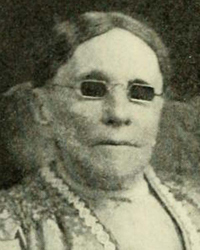History of Hymns: "To God Be the Glory"
“To God Be the Glory”
Fanny J. Crosby
UM Hymnal, No. 98
To God be the glory, great things he hath done!
So loved he the world that he gave us his Son,
who yielded his life an atonement for sin,
and opened the life-gate that all may go in.
Praise the Lord, praise the Lord,
let the earth hear his voice!
Praise the Lord, praise the Lord,
let the people rejoice!
O come to the Father through Jesus the Son,
and give him the glory, great things he hath done.
How hymns travel throughout space and time is fascinating. “To God Be the Glory” was included in William H. Doane’s Songs of Devotion in 1870 indicating that it was written at least five years earlier than the date of 1875 that is usually cited.
Ira Sankey probably saw the hymn in Doane’s collection and incorporated it into the first edition of his Sacred Songs and Solos (1875). Sankey and Dwight Moody helped to establish the hymn’s popularity during their revivals in Great Britain in the late 19th century. It also appeared in some British hymnals including the Methodist Hymn Book (1933).
However, it was not until the Billy Graham Crusade of 1954 in Nashville, Tenn., that the Rev. Cliff Barrows, the song leader for the Graham team, introduced this hymn to congregations in the United States. The Rev. Graham and Mr. Barrows had learned the song during revivals that they conducted in Great Britain in 1952.
 |
| Fanny Crosby |
Hymnologist William J. Reynolds, writing in his hymnal companion Hymns of Faith (1964), documented the return of this now favorite Fanny Crosby hymn to the U.S. and spoke of the hymn’s significance: “It is most extraordinary that this long-forgotten American gospel song should have been imported from England and become immensely popular during the last decade. . . . [The hymn is] an expression of objectivity not usually found in gospel hymnody. Here is a straightforward voicing of praise to God, not simply personal testimony nor sharing some subjective aspect of Christian experience.”
The hymns of Frances Jane Crosby—her married name was Frances van Alstyne—have historically been among the most popular songs sung by Methodists. Crosby (1820-1915), blinded at six weeks of age, was a lifelong Methodist and began composing hymns at age six. She became a student at the New York Institute of the Blind at age 15 and joined the faculty of the Institute at 22, teaching rhetoric and history. Her hymn texts were staples for the music of the most prominent gospel songwriters of her day.
The words and music of “To God Be the Glory” were included in the collection Brightest and Best (1875) under the title “Praise for Redemption.” UM Hymnal editor, the Rev. Carlton Young, notes that the music by William Doane (1832-1915), a composer for many of Crosby’s texts, “is a perfect match for these words of glory and praise to God in Christ Jesus.”
Most gospel songs center on Christ, but this hymn directly addresses God, who has done great things. The primary focus of God’s actions, however, is on the redemption of humanity through Jesus Christ. The second line of the first stanza, “So loved he the world that he gave us his Son,” echoes John 3:16.
The second stanza, though referring to “the promise of God,” centers on Christ, the “perfect redemption, the purchase of blood.” In the third stanza, the pronoun “he” is somewhat vague in its reference: Is “he” referring to God or to Jesus? The focus is again on Christ who is “our wonder [and] our transport,” and the one that we long to see in glory.
Theologically, the author blurs the actions of the Father and the work of the Son. The concluding phrase of the refrain contributes to this: “O come to the Father through Jesus the Son, and give him the glory, great things he hath done.” The pronoun “him” is closest in proximity in the sentence to “Jesus the Son.” Yet, the hymn opens with “To God be the glory,” leading one to think that the pronoun could refer also to God.
Perhaps this seems like a trivial point. Rather than accusing Crosby of a sloppy use of pronouns, it is more likely an indication of the supremacy of Christ in the theology of evangelicals in the late 19th and early 20th century—and indeed to this day. Few gospel songs express gratitude to God as creator of the universe or to God’s providence in our lives. For evangelicals, God’s primary role may be found in the gift of Jesus Christ, the redeemer of the world and God’s greatest gift to humanity—the thesis of John 3:16.
Hymnologist J.R. Watson voices a British perspective on this hymn from the country where it has been well known for over a century: “It is simple in its ideas, but forceful in their expression, relying on a fortissimo emotionalism which is entirely appropriate for certain kinds of religious gathering.”
Dr. Hawn is professor of sacred music at Perkins School of Theology.
Contact Us for Help
View staff by program area to ask for additional assistance.
